常见佛教英语
关于宗教的英语单词
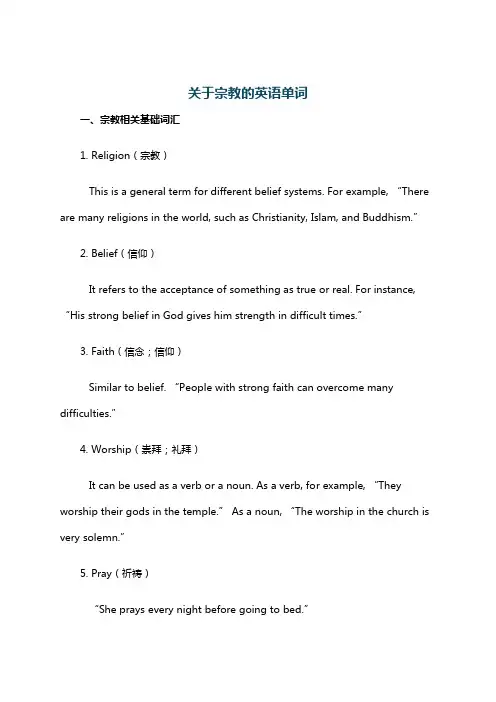
关于宗教的英语单词一、宗教相关基础词汇1. Religion(宗教)This is a general term for different belief systems. For example, “There are many religions in the world, such as Christianity, Islam, and Buddhism.”2. Belief(信仰)It refers to the acceptance of something as true or real. For instance, “His strong belief in God gives him strength in difficult times.”3. Faith(信念;信仰)Similar to belief. “People with strong faith can overcome many difficulties.”4. Worship(崇拜;礼拜)It can be used as a verb or a noun. As a verb, for example, “They worship their gods in the temple.” As a noun, “The worship in the church is very solemn.”5. Pray(祈祷)“She prays every night before going to bed.”6. Priest(牧师;神父;祭司等神职人员)In Christianity, a priest conducts religious ceremonies. “The priest gavea sermon in the church on Sunday.”7. Monk(和尚;僧侣)In Buddhism, a monk lives a simple and religious life. “The monk meditates for hours every day.”8. Nun(修女;尼姑)For example, “The nun devotes her life to serving God in the convent.”二、主要宗教名称1. Christianity(基督教)It is based on the life and teachings of Jesus Christ. It has different denominations, such as Catholicism(天主教), Protestantism(新教)and Orthodox Christianity(东正教). For example, “Many people in Europe follow Christianity.”2. Islam(伊斯兰教)Muslims follow the teachings of the Quran. “Islam has a great influence in the Middle East and many other parts of the world.”3. Buddhism(佛教)Originated in ancient India. “Buddhism emphasizes enlightenment and the end of suffering.”4. Hinduism(印度教)It is one of the major religions in India. “Hinduism has a complex system of beliefs and practices.”5. Judaism(犹太教)It is the religion of the Jewish people. “Judaism has a long history and unique religious traditions.”三、宗教场所相关词汇1. Church(教堂,主要指基督教教堂)“The church in the town center is very beautiful. People go there to worship on Sundays.”2. Mosque(清真寺,伊斯兰教礼拜场所)“The mosque is an important place for Muslims to pray.”3. Temple(寺庙,可指佛教、印度教等寺庙)In Buddhism, “The Buddhist temple is full of peace and tranquility.” In Hinduism, “The Hindu temple has elaborate sculptures.”4. Synagogue(犹太教堂)“Jews gather in the synagogue for religious services.”四、宗教仪式与物品相关词汇1. Bible(圣经,基督教经典)“Christians study the Bible to understand their faith.”2. Quran(古兰经,伊斯兰教经典)“Muslims believe that the Quran is the word of God.”3. Sutra(佛经,佛教经典)“Monks often chant sutras in the temple.”4. Mass(弥撒,天主教的一种宗教仪式)“The priest conducts the Mass in the church.”5. Ramadan(斋月,伊斯兰教的一个重要月份)“During Ramadan, Muslims fast from dawn to dusk.”6. Altar(祭坛;圣坛,在宗教场所用于供奉或举行仪式的地方)In a church, “The priest stands in front of the altar during the service.”In a temple, “Offerings are placed on the altar.”。
旅游英语 佛教

• Buddhism was founded in the sixth century BC. It was the earliest among the world's major religions. The founder was Sakyamuni whose nationality was in today’s Nepal , which belonged to India in ancient time. Therefore , India is the birthplace of Buddhism.
4.人生在世如身处荆棘之中,心不动,人 不妄动,不动则不伤;如心动则人妄动, 伤其身痛其骨,于是体会到世间诸般痛 苦。叫我们不要胡思乱想 现量见物 .
5.一花一世界,一佛一如来。 一花一世界,一草一天堂,一叶一如来, 一砂一极乐,一方一净土,一笑一尘缘, 一念一清静。 这一切都是一种心境。心若无物就可以 一花一世界,一草一天堂。参透这些, 一花一草便是整个世界,而整个世界也 便空如花草!
. Under the support and help from Chinese government and other countries, the development of Chinese Buddhism is prosperous. We can say Chinese Buddhism derived from the ancient India , developed in China and affected all the world.
Thank you!
The spread of Buddhism
1. Northern Buddhism(北传佛教):
宗教相关词汇英语翻译.doc
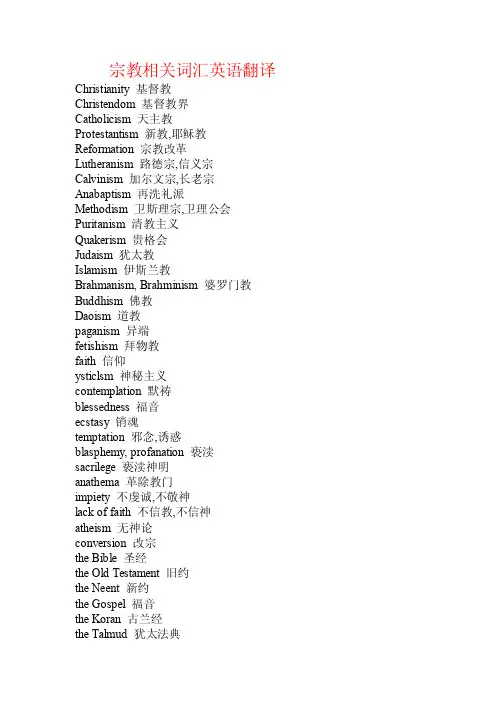
宗教相关词汇英语翻译Christianity 基督教Christendom 基督教界Catholicism 天主教Protestantism 新教,耶稣教Reformation 宗教改革Lutheranism 路德宗,信义宗Calvinism 加尔文宗,长老宗Anabaptism 再洗礼派Methodism 卫斯理宗,卫理公会Puritanism 清教主义Quakerism 贵格会Judaism 犹太教Islamism 伊斯兰教Brahmanism, Brahminism 婆罗门教Buddhism 佛教Daoism 道教paganism 异端fetishism 拜物教faith 信仰ysticlsm 神秘主义contemplation 默祷blessedness 福音ecstasy 销魂temptation 邪念,诱惑blasphemy, profanation 亵渎sacrilege 亵渎神明anathema 革除教门impiety 不虔诚,不敬神lack of faith 不信教,不信神atheism 无神论conversion 改宗the Bible 圣经the Old Testament 旧约the Neent 新约the Gospel 福音the Koran 古兰经the Talmud 犹太法典abbey 大修道院,大教堂basilica 大教堂cathedral 教堂,主教座堂church 教堂,礼拜堂chapel 小教堂synagogue 犹太教堂collegiate church 牧师会主持的教堂nave 教堂中殿transept 教堂的十字型翼部temple 庙宇sanctuary 圣所,神殿convent 女修道院monastery, cloister 修道院mosque 清真寺hermitage 偏僻的寺院high altar 祭坛pagoda 塔,佛塔choir 唱诗班cross 十字架icon 圣像monstrance 圣体匣tabernacle 圣体龛ciborium, pyx 圣体容器,圣饼盒chalice 圣杯font 洗礼池holy- 圣水掸酒器censer, thurible 香炉pulpit 讲道台stained glass ass 弥撒High Mass 大弥撒sung mass 唱诗弥撒Loon 讲经psalm 圣诗canticle 赞美诗Via Crucis, Way of the Cross 十字架路,耶稣赴难路procession 宗教游行Rosary 念珠。
佛教英语词汇对照总集
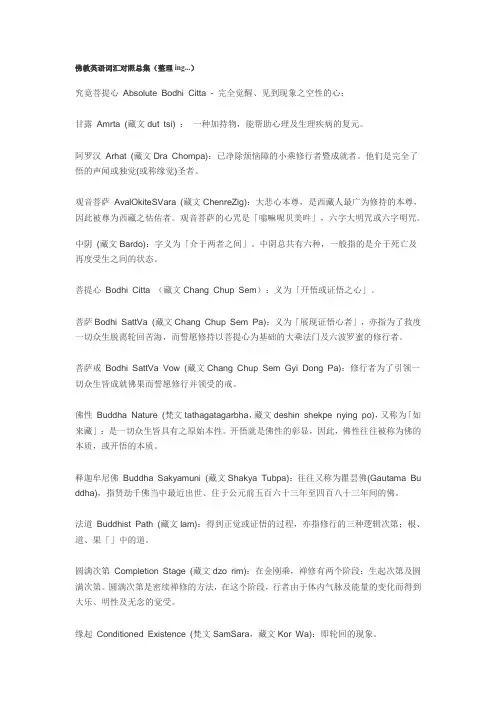
佛教英语词汇对照总集(整理ing...)究竟菩提心Absolute Bodhi Citta - 完全觉醒、见到现象之空性的心;甘露Amrta (藏文dut tsi) :一种加持物,能帮助心理及生理疾病的复元。
阿罗汉Arhat (藏文Dra Chompa):已净除烦恼障的小乘修行者暨成就者。
他们是完全了悟的声闻或独觉(或称缘觉)圣者。
观音菩萨AvalOkiteSVara (藏文ChenreZig):大悲心本尊,是西藏人最广为修持的本尊,因此被尊为西藏之怙佑者。
观音菩萨的心咒是「嗡嘛呢贝美吽」,六字大明咒或六字明咒。
中阴(藏文Bardo):字义为「介于两者之间」。
中阴总共有六种,一般指的是介于死亡及再度受生之间的状态。
菩提心Bodhi Citta (藏文Chang Chup Sem):义为「开悟或证悟之心」。
菩萨Bodhi SattVa (藏文Chang Chup Sem Pa):义为「展现证悟心者」,亦指为了救度一切众生脱离轮回苦海,而誓愿修持以菩提心为基础的大乘法门及六波罗蜜的修行者。
菩萨戒Bodhi SattVa Vow (藏文Chang Chup Sem Gyi Dong Pa):修行者为了引领一切众生皆成就佛果而誓愿修行并领受的戒。
佛性Buddha Nature (梵文tathagatagarbha,藏文deshin shekpe nying po),又称为「如来藏」:是一切众生皆具有之原始本性。
开悟就是佛性的彰显,因此,佛性往往被称为佛的本质,或开悟的本质。
释迦牟尼佛Buddha Sakyamuni (藏文Shakya Tubpa):往往又称为瞿昙佛(Gautama Bu ddha),指贤劫千佛当中最近出世、住于公元前五百六十三年至四百八十三年间的佛。
法道Buddhist Path (藏文lam):得到正觉或证悟的过程,亦指修行的三种逻辑次第;根、道、果「」中的道。
圆满次第Completion Stage (藏文dzo rim):在金刚乘,禅修有两个阶段:生起次第及圆满次第。
英语课程中的宗教与信仰词汇
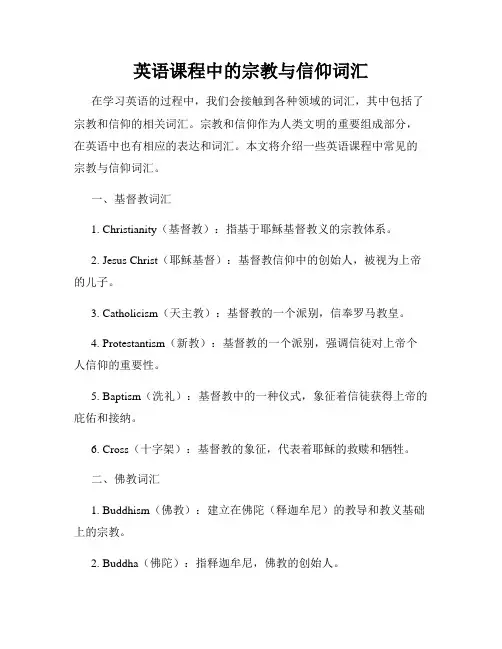
英语课程中的宗教与信仰词汇在学习英语的过程中,我们会接触到各种领域的词汇,其中包括了宗教和信仰的相关词汇。
宗教和信仰作为人类文明的重要组成部分,在英语中也有相应的表达和词汇。
本文将介绍一些英语课程中常见的宗教与信仰词汇。
一、基督教词汇1. Christianity(基督教):指基于耶稣基督教义的宗教体系。
2. Jesus Christ(耶稣基督):基督教信仰中的创始人,被视为上帝的儿子。
3. Catholicism(天主教):基督教的一个派别,信奉罗马教皇。
4. Protestantism(新教):基督教的一个派别,强调信徒对上帝个人信仰的重要性。
5. Baptism(洗礼):基督教中的一种仪式,象征着信徒获得上帝的庇佑和接纳。
6. Cross(十字架):基督教的象征,代表着耶稣的救赎和牺牲。
二、佛教词汇1. Buddhism(佛教):建立在佛陀(释迦牟尼)的教导和教义基础上的宗教。
2. Buddha(佛陀):指释迦牟尼,佛教的创始人。
3. Zen(禅宗):佛教的一个分支,强调通过冥想来获得启示和觉醒。
4. Enlightenment(觉悟):佛教追求的境地,意味着彻底的开悟和解脱。
5. Karma(业力):佛教中的一个重要概念,指个人行为所带来的因果关系。
6. Meditation(冥想):佛教修行的一种方法,通过专注和静思来实现内心的平静与洞察。
三、伊斯兰教词汇1. Islam(伊斯兰教):信仰主义安拉为唯一上帝的宗教。
2. Muhammad(穆罕默德):伊斯兰教的创始人,被尊称为先知。
3. Mosque(清真寺):伊斯兰教的宗教场所,用于聚集礼拜和做祷告。
4. Qur'an(古兰经):伊斯兰教的圣典,认为是安拉启示给穆罕默德的言论。
5. Ramadan(斋月):伊斯兰教每年的一个重要节日,信徒在此期间禁食和反思。
6. Hajj(朝觐):伊斯兰教的一种仪式,信徒前往麦加朝拜圣地。
四、其他宗教与信仰词汇1. Hinduism(印度教):印度次大陆的主要宗教,信奉多神教。
佛教相关英语词汇
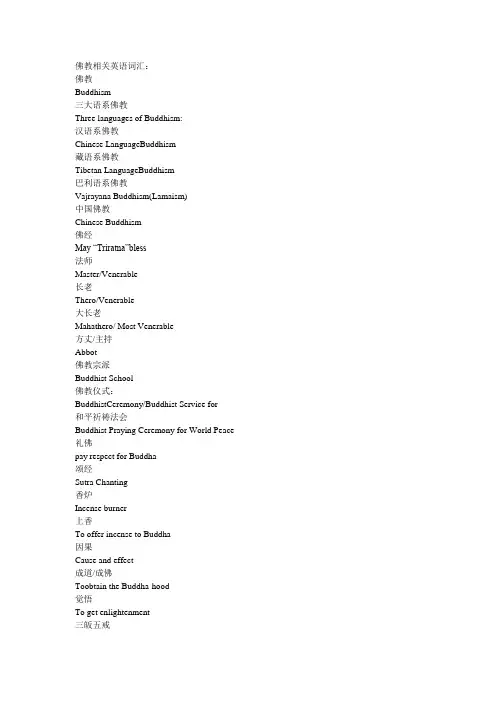
佛教相关英语词汇:佛教Buddhism三大语系佛教Three languages of Buddhism:汉语系佛教Chinese LanguageBuddhism藏语系佛教Tibetan LanguageBuddhism巴利语系佛教Vajrayana Buddhism(Lamaism)中国佛教Chinese Buddhism佛经May “Triratna”bless法师Master/Venerable长老Thero/Venerable大长老Mahathero/ Most Venerable方丈/主持Abbot佛教宗派Buddhist School佛教仪式:BuddhistCeremony/Buddhist Service for和平祈祷法会Buddhist Praying Ceremony for World Peace 礼佛pay respect for Buddha颂经Sutra Chanting香炉Incense burner上香To offer incense to Buddha因果Cause and effect成道/成佛Toobtain the Buddha-hood觉悟To get enlightenment三皈五戒The ceremony for lay Buddhists to go to the Buddha for refuge, goto the Dharma for refuge, go to the Sangha forrefuge and to follow the five commandments of Buddhism(no killing,no stealing,no sexualmisconduct,no lying,no intoxicant)诸恶莫做,众善奉行,自净其意,既是佛教“To do no evil, to do only good, to purify the will, is thedoctrine of all Buddhas”做功德To make contribution to普渡终生To save all living beings from sufferingsAmitabha 阿弥陀佛Avalokiteshvara 观音Bhodisattva 菩萨释迦牟尼佛Buddha Sakyamuni观音菩萨AvalOkiteSVaraffinities 因缘* (with emphasis on good relationships)All living beings have the Buddha-nature; all can become Buddhas. 一切众生,皆有佛性,皆堪作佛。
佛教专用词汇英语
Ananda 阿難One of the Shakyamuni Buddha's Ten Great Disciples. He was first in hearing the Buddha's words. As he had excellent memory, he memorized the Buddha's sermons, which were later recorded as sutras. He was also the cousin of Shakyamuni Buddha。
Arhat 阿羅漢Arhat in Sanskrit, Arahat in Pali. Literally, man of worth, honourable one. There are two kinds of arhats, namely, the Sound-hearing arhat (Sravaka) and the Enlightened-to-condition arhat (Praetyka-Buddha). The former attains the wisdom to understand the Four Noble Truth, while the latter attains the wisdom to understand the Law of Dependent Origination or the Twelve Links of Dependent Origination. They represent two vehicles, who "comprehend for their own sake". As they pay attention to themselves and not to others, they are incapable of genuine and equal enlightenment. There are four noble stages of fruition in the Arhat Path.。
佛教相关英语词汇
佛教相关英语词汇:佛教Buddhi sm三大语系佛教Threelangua ges of Buddhi sm:汉语系佛教Chines e Langua geBud dhism藏语系佛教Tibeta n Langua geBud dhism巴利语系佛教Vajray ana Buddhi sm(Lamais m)中国佛教Chines e Buddhi sm佛经May“Trirat na”bless法师Master/Venera ble长老Thero/Venera ble大长老Mahath ero/ Most Venera ble方丈/主持Abbot佛教宗派Buddhi st School佛教仪式:Buddhi stCer emony/Buddhi st Servic e for和平祈祷法会Buddhi st Prayin g Ceremo ny for WorldPeace礼佛pay respec t for Buddha颂经SutraChanti ng香炉Incens e burner上香To offerincens e to Buddha因果Causeand effect成道/成佛Toobta in the Buddha-hood觉悟To get enligh tenme nt三皈五戒The ceremo ny for lay Buddhi sts to go to the Buddha for refuge, goto the Dharma for refuge, go to the Sangha forref uge and to follow the five comman dment s of Buddhi sm(no killin g,no steali ng,no sexual misco nduct,no lying,no intoxi cant)诸恶莫做,众善奉行,自净其意,既是佛教“To do no evil, to do only good, to purify the will, is thedoc trine of all Buddha s”做功德To make contri butio n to普渡终生To save all living beings from suffer ingsAmitab ha 阿弥陀佛Avalok itesh vara观音Bhodis attva菩萨释迦牟尼佛 Buddha Sakyam uni观音菩萨AvalOk iteSV araffini ties因缘* (with emphasi s on good relati onshi ps)All living beings have the Buddha-nature; all can become Buddha s. 一切众生,皆有佛性,皆堪作佛。
佛法用语英语词汇表
Khandhas or Aggregates – These are the five groupings that comprise body and mind: form, feeling, memory, mental formations, and consciousness. Regular, non-enlightened human beings are deluded in believing that they are these khandas and have not realized the truth that there is no self.
智慧 – 佛教里所指的真正的智慧,不是智力上的知识,它经由直接的体验,如实看见事物的真相。这里是意味着至少看到身心三法印中的一项:无常(总是变化的),苦(不能持续),无我(不受控制的)。这在正文中已详细解释。
Mindfulness – Awareness of physical or mental phenomena. More specially, awareness of what the body is doing in real time, or recognizing what mental phenomena or behaviours have just arisen. Genuine mindfulness arises automatically as result of the practitioner’s ability to be aware of the body and to recognize mental phenomena when they arise.
佛教词汇翻译
原文地址:常用佛教名词英语翻译作者:禅咖一味Buddha, Dharma and Sangha. 佛,法,僧。
释迦摩尼:Siddhartha Gautam合十:Namaste佛法:Dharma佛教:BuddhismFour Heavenly Kings 四天王karma 因果Buddha Amitaba 阿弥陀佛Buddha of Sunlight (法身佛)毗卢遮那佛Buddha Sakyamuni 释迦牟尼佛bodhi 菩提dhyana 禅那sangha 僧团saha 娑婆“Our body be a bodhi tree,Our mind be a mirror bright,Clean and polish frequently,Let no dust alight.身是菩提树,心如明镜台,时时勤拂拭,勿使惹尘埃。
”“There is no bodhi tree,Nor stand of a mirror bright,Since all is void,Where can the dust alight?菩提本无树,明镜亦非台,本来无一物,何处惹尘埃?”究竟菩提心Absolute Bodhi Citta - 完全觉醒、见到现象之空性的心;甘露Amrta (藏文dut tsi) :一种加持物,能帮助心理及生理疾病的复元。
阿罗汉Arhat (藏文Dra Chompa):已净除烦恼障的小乘修行者暨成就者。
他们是完全了悟的声闻或独觉(或称缘觉)圣者。
观音菩萨AvalOkiteSVara (藏文ChenreZig):大悲心本尊,是西藏人最广为修持的本尊,因此被尊为西藏之怙佑者。
观音菩萨的心咒是「嗡嘛呢贝美吽」,六字大明咒或六字明咒。
中阴(藏文Bardo):字义为「介于两者之间」。
中阴总共有六种,一般指的是介于死亡及再度受生之间的状态。
菩提心BodhiCitta (藏文Chang Chup Sem):义为「开悟或证悟之心」。
- 1、下载文档前请自行甄别文档内容的完整性,平台不提供额外的编辑、内容补充、找答案等附加服务。
- 2、"仅部分预览"的文档,不可在线预览部分如存在完整性等问题,可反馈申请退款(可完整预览的文档不适用该条件!)。
- 3、如文档侵犯您的权益,请联系客服反馈,我们会尽快为您处理(人工客服工作时间:9:00-18:30)。
常见佛教英语佛教Buddhism三大语系佛教Three languages of Buddhism:汉语系佛教Chinese Language Buddhism藏语系佛教Tibetan Language Buddhism巴利语系佛教Pali Language Buddhism大乘佛教Mahayana Buddhism上座部佛教Theravada Buddhism金刚乘/密宗Vajrayana Buddhism(Lamaism)中国佛教Chinese Buddhism佛经Sutra经、律、论Sutras, Vinaya, Sastra大藏经Tripitaka Sutra三宝(佛、法、僧)Triratna (Buddha, Dharma,Sangha)“三宝”加被May “Triratna”bless法师Master/Venerable长老Thero/Venerable大长老Mahathero/ Most V enerable方丈/主持Abbot佛教宗派Buddhist School佛教仪式:Buddhist Ceremony/Buddhist Service for和平祈祷法会Buddhist Praying Ceremony for World Peace礼佛pay respect for Buddha颂经Sutra Chanting香炉Incense burner上香To offer incense to Buddha因果Cause and effect成道/成佛To obtain the Buddha-hood觉悟To get enlightenment三皈五戒The ceremony for lay Buddhists to go to the Buddha for refuge, go to the Dharma for refuge, go to the Sangha for refuge and to follow the five commandments of Buddhism(no killing,no stealing,no sexual misconduct,no lying,no intoxicant)诸恶莫做,众善奉行,自净其意,既是佛教“To do no evil, to do only good, to purify the will, is thedoctrine of all Buddhas”做功德To make contribution to普渡终生To save all living beings from sufferings四谛Four noble truths八正道Eight noble paths善哉Sadhu (good or excellent)佛教寺院Monastery/Buddhist Temple山门The Front Gate大雄宝殿The Main Shrine Hall圆通殿The Hall of Universal Understanding观音殿The Hall of Avalokitesvara Buddhisatva藏经阁The Tripitaka Sutra Pavilion罗汉堂The Hall of Arhan祖师殿The Hall of Patriarch四大天王Four deva-kings, the protectors of Buddhism韦驮Vitasoka/Vigatasoka, the protector of Buddhism斋堂Monastic Dinning Hall客堂Monastic Reception四大名山:Four holy mountains of Chinese Buddhism五台山Wutai Mountain is the Holy Place of Manjusri Buddhisattva峨嵋山Ermei Mountain is the Holy Place of Mahasthama Buddhisattva 九华山Jiuhua Mountain is the holy place of Ksitigarbha Buddhisattva 普陀山Putuo Mountain is the holy place of Avalokitesvara Buddhisattva 佛像Buddha statue释迦牟尼佛Shakyamuni Buddha弥勒佛Maitreya Buddha迦叶佛Kasyapa Buddha阿弥陀佛Amitaba Buddha毗庐舍那佛Vairocana Buddha药师佛Bhaisajya Buddha/medicine Buddha三世佛Buddhas of Three Periods:Kasyapa Buddha of the pastShakyamuni Buddha of the present,Maitrya Buddha of the future菩萨Buddhisattva观世音菩萨Avalokitesvara Buddhisattva菩贤菩萨Samandhabatra Buddhisattva大势智菩萨Mahasthamaprapta Buddhisattva文殊菩萨Manjusri Buddisattva地藏菩萨ksitigahba Buddhisattva善财童子Sudhana罗汉Arhan西方三圣:阿弥陀佛、观音菩萨、大势至菩萨Amitaba BuddhaAvalokitesvara BuddhisattvaMahasthamaprapta Buddhisattva达摩Budhidharma摩腾Kasyapa Matanga竺法兰Gobharana/Dharmaraksa佛学院Buddhist College僧伽Sangha僧、尼(比丘、比丘尼)monk、nun /Bhiksu, Bhiksuni方丈/主持Abbot首座Chief monk监院/当家Monastic Manger侍者Assistant中国佛教协会The Buddhist Association of China中国佛学院The Buddhist Academy of China会长President副会长Vice President秘书长Secretary General副秘书长Deputy Secretary General佛学英语词汇the Great Vehicle d大乘the Lesser Vehicle 小乘the Diamond Vehicle 金刚乘Four Noble Truths 四圣谛苦suffering集causes of suffering灭suppression of suffering 道path to suppression of sufferingTwelve Links in the Chain of Causation 十二因缘cycle of rebirths 轮回ignorance 惑nirvana 涅磐greed 贪hatred 嗔stupidity 痴pride 慢hesitation 疑wrong view 恶见no-soul 无我impermanence 无常sentient beings 众生deva 天human 人asura 阿修罗animal 畜牲hungry ghost 饿鬼denizen of hell 地狱morality 戒concentration 定wisdom 慧action 身speech 口consciousness 意lay Buddhists 居士novice monks 沙弥monks 比丘Five Precepts 五戒personal enlightenment 自觉universal enlightenment 觉他full enlightenment 觉满Buddha of Medicine 药师佛Buddha Maitreya 弥勒佛body of essence 法身award body 报身body of transformation 化身Four Heavenly Kings 四天王karma 因果Buddha Amitaba 阿弥陀佛Buddha of Sunlight (法身佛)毗卢遮那佛Buddha Sakyamuni 释迦牟尼佛Bodhisattva of Compassion 观音菩萨Boohisattva of Ultimate Knowledge 文殊菩萨Bodhisattva of Universal Benevolence 普贤菩萨Bodhisattva of Great Power 大势至菩萨bodhi 菩提dhyana 禅那sangha 僧团saha 娑婆五蕴five aggregates色aggregate of material body受aggregate of feelings想aggregate of perceptions 行aggregate of predispositions识aggregate of consciousness简单佛学英语Birth is suffering; aging is suffering;生是苦;老是苦;sickness is suffering; death is suffering;病是苦;死是苦;association with the unpleasant is suffering;怨憎会是苦;dissociation from the pleasant is suffering;爱别离是苦;not to get what one wants is suffering;求不得是苦;in short, attachment to the five aggregates is suffering.简言之,对五蕴的执取就是苦。
When past conditioning is erased and no fresh one produced,当过去的诸行都根除了,并且也无新的产生,the mind no longer seeks for future birth.心不再企求来生。
The seed consumed, cravings no more arise.种子耗尽,渴爱不再。
Such-minded wise ones cease like [the flame of] this lamp.智者的心有如灯熄焰灭。
Impermanent are all compounded things.诸行无常,When one perceives this with true insight,洞察及此,then one becomes detached from suffering;便能离苦;this is the path of purification.此即净化之道。
